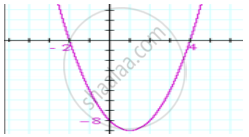Advertisements
Advertisements
Question
If graph of quadratic polynomial ax2 + bx + c cuts positive direction of y-axis, then what is the sign of c?
Solution
If graph of quadratic polynomial `f(x)=ax^2 + bx + c` cuts positive direction of y−axis, then
Put x = 0 for the point of intersection of the polynomial and y−axis
We have `y = 0+0+c+c`
Since the point `(0,c)` is above the x-axis
Hence, the sign of c is positive, that is `c > 0`
APPEARS IN
RELATED QUESTIONS
Write the standard form of a linear polynomial with real coefficients.
Write the standard form of a quadratic polynomial with real coefficients.
In Q. No. 14, write the sign of c.
If f(x) = x3 + x2 − ax + b is divisible by x2 − x write the value of a and b.
If α and β are the zeros of the polynomial f(x) = x2 + px + q, then a polynomial having \[\frac{1}{\alpha} \text{and}\frac{1}{\beta}\] is its zero is
If the product of zeros of the polynomial f(x) ax3 − 6x2 + 11x − 6 is 4, then a =
Divide. Write the quotient and the remainder.
(25m4 − 15m3 + 10m + 8) ÷ 5m3
An asana is a body posture, originally and still a general term for a sitting meditation pose, and later extended in hatha yoga and modern yoga as exercise, to any type of pose or position, adding reclining, standing, inverted, twisting, and balancing poses. In the figure, one can observe that poses can be related to representation of quadratic polynomial.


The two zeroes in the below shown graph are:

`sqrt(2)` is a polynomial of degree ______.
Classify the following as a constant, linear, quadratic and cubic polynomials:
`5t - sqrt(7)`
